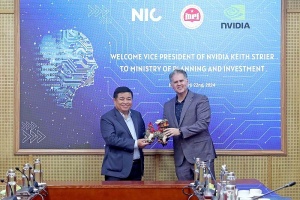A strengthened high-tech workforce for semiconductors
With the increasing demand in the semiconductor industry investment and development, what are Vietnam’s potentials and strengths?
| Dr. Quan Le, principal investigator for the Semiconductor Workforce Development Research Grant under Fulbright University Vietnam |
Vietnam’s strengths in the semiconductor industry lie in its ecosystem and geopolitical position. The semiconductor industry is broad, and I divide it into manufacturing, design, and assembly, testing, and packaging (ATP).
Overall, Vietnam’s strength lies in its geopolitical position, being close to China, South Korea, and Taiwan. This proximity allows Vietnam to deeply integrate into the supply chain due to easy and convenient transportation of goods. Specifically, Vietnam has a robust domestic electronics manufacturing industry. Vietnam manufactures for Foxconn, Samsung, and has many domestic electronics plants. Therefore, transitioning this labour force into ATP for the semiconductor industry is convenient.
In terms of design, Vietnam already has many companies involved in this field, producing fairly complex designs. Thus, in terms of human resource capacity for investment and development in the semiconductor industry, I am highly optimistic.
Additionally, government policies are favourable. Vietnam’s National Innovation Centre (NIC) is doing well in focusing on investment and developing the semiconductor ecosystem in Vietnam through workshops, events, and, most recently, collaboration with Siemens EDA.
With such potentials and strengths, how is Vietnam’s high-tech workforce currently evaluated?
The semiconductor industry is a long journey, requiring investment and time to yield results. For example, the new Amkor factory in the northern province of Bac Ninh said it would take several years to train its initial workforce before operating at full capacity.
In the semiconductor industry, there is no specific discipline called “semiconductors”; it spans electrical, electronic, automation engineering, and materials engineering. Vietnam’s high-tech workforce currently has certain strengths. Firstly, in terms of relevant graduates, Vietnam produces a significant number.
Secondly, the quality of basic education in the country is commendable. The United States highly regards Vietnam’s quality of basic education. Therefore, the basic conditions for an initial workforce are satisfactory. However, we currently lack comprehensive semiconductor training programmes. This is a new field for us, so we need to supplement knowledge to prepare this workforce for the industry’s future demands.
What are the weaknesses in the current vocational education and training system, and what recommendations are proposed?
Vietnam’s workforce has good capabilities, but its weaknesses include poor teamwork skills, inadequate English proficiency, and weak interdisciplinary knowledge. Vietnamese engineers have deep and excellent specialised knowledge, but they lack the ability to integrate and coordinate knowledge across disciplines. Therefore, it is essential for educational institutions to train engineers not only in their specialities but also in Vietnamese literature and art appreciation to discern what constitutes good and beautiful products. Interdisciplinary knowledge will enable the workforce to adapt well to new requirements in the semiconductor industry’s development process.
Vietnam has universities that excel in engineering education, producing highly regarded engineers, but they also have weaknesses, as mentioned above. To address this issue, I propose some recommendations. Firstly, expand project-based learning in courses, where students are assigned practical tasks and must collaborate in teams to complete them. Secondly, and more importantly, educators should have close collaboration with companies.
How does the current training capacity of the domestic education and vocational training system in Vietnam meet the demand for high-tech development?
The NIC leads the project to train Vietnam’s workforce in this industry and has forecasted a large number of engineers needed for the semiconductor industry and associated technologies such as electronics manufacturing, up to tens of thousands of engineers.
Currently, Vietnam only has a few recognised specialised training institutions for integrated circuits, with a very small number of graduates. To achieve the NIC’s goal of developing Vietnam’s high-tech workforce, it needs to upgrade and expand its training capacity even further.
Additionally, the traditional training approach, which involves long-term programmes that take four years to produce a batch of graduates, is insufficient for the semiconductor industry. Therefore, the importance of short courses to supplement and enhance the skills of the workforce quickly cannot be overstated. It is crucial for the workforce to closely coordinate with the practical requirements of companies. In the semiconductor industry, each company’s work processes are different, so having employees who are trained based on the specific needs of each company will expedite the process.
Currently, electronic engineers and technicians are being transitioned to studying semiconductor technology. Should the current vocational education and training system introduce a new major in semiconductors or supplement short courses from traditional fields?
Under the project “Strengthening high-tech workforce development to increase Vietnam’s competitiveness in the semiconductor industry,” sponsored by the US Department of State and led by Fulbright University Vietnam, experts convened on April 2 to discuss two different trends. The first trend is to establish a specialised training programme with deep and prolonged knowledge. The second trend is short courses to quickly supplement knowledge.
Vietnam needs both and should coordinate closely between the two. However, in the near term, as Vietnam urgently needs to advance in the semiconductor industry, organising short courses to supplement knowledge for engineers on-site is essential.
Another advantage for Vietnam is that engineers graduate with a background in electronics engineering, automation engineering, and then add knowledge from these short courses to quickly understand and apply semiconductor industry practices.
When Vietnam’s semiconductor industry reaches a certain level of development, and there is a more stable demand for human resources, then establishing a long-term training programme becomes reasonable.
 | Chip industry taking on new players Domestic and foreign investors alike are supporting Vietnam’s semiconductor strategy by making numerous commitments to invest in chip manufacturing. |
 | MPI meets with Nvidia vice president to discuss AI and semiconductor cooperation Minister of Planning and Investment Nguyen Chi Dung met with vice president of US tech firm Nvidia Keith Strier on April 22 to discuss Vietnam's semiconductor and AI ecosystem. |
 | Localities on first step towards training microchip labour force A number of localities are coordinating with manufacturers to train workers for the semiconductor industry, mostly in the basic stages of assembly and testing. |
What the stars mean:
★ Poor ★ ★ Promising ★★★ Good ★★★★ Very good ★★★★★ Exceptional
Related Contents
Latest News
More News
- Businesses ramp up production as year-end orders surge (December 30, 2025 | 10:05)
- Vietjet chairwoman awarded Labour Hero title (December 29, 2025 | 13:06)
- How to unlock ESG value through green innovation (December 29, 2025 | 10:03)
- AI reshapes media and advertising industry (December 29, 2025 | 08:33)
- FPT and GELEX sign deal to develop blockchain tech for global markets (December 29, 2025 | 08:29)
- Vietnam’s GDP forecast to grow by 9 per cent in 2026 (December 29, 2025 | 08:29)
- Women entrepreneurs are key to Vietnam’s economic growth (December 29, 2025 | 08:00)
- Vietnam's top 500 value-creating enterprises announced (December 27, 2025 | 08:00)
- The PAN Group shaping a better future with ESG strategy (December 26, 2025 | 09:00)
- Masan Consumer officially lists on HSX, marking the next phase of value creation (December 25, 2025 | 13:20)

 Tag:
Tag:




















 Mobile Version
Mobile Version